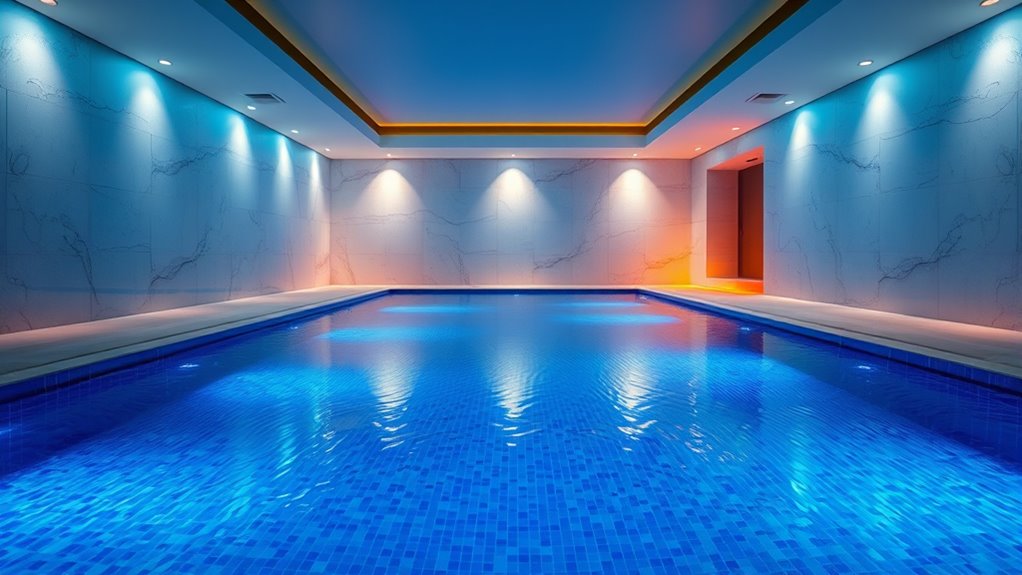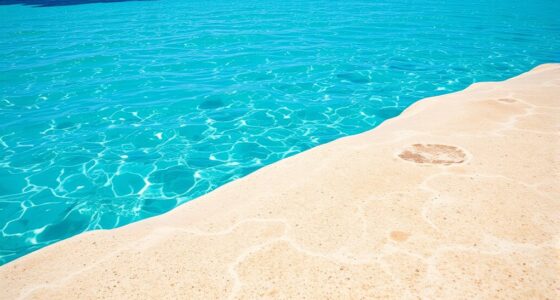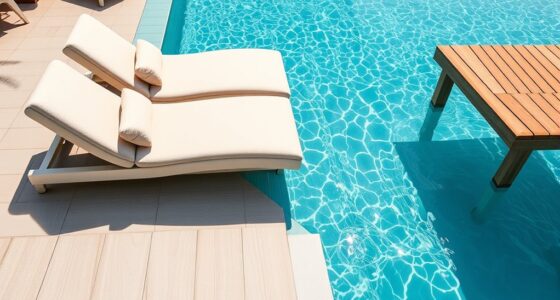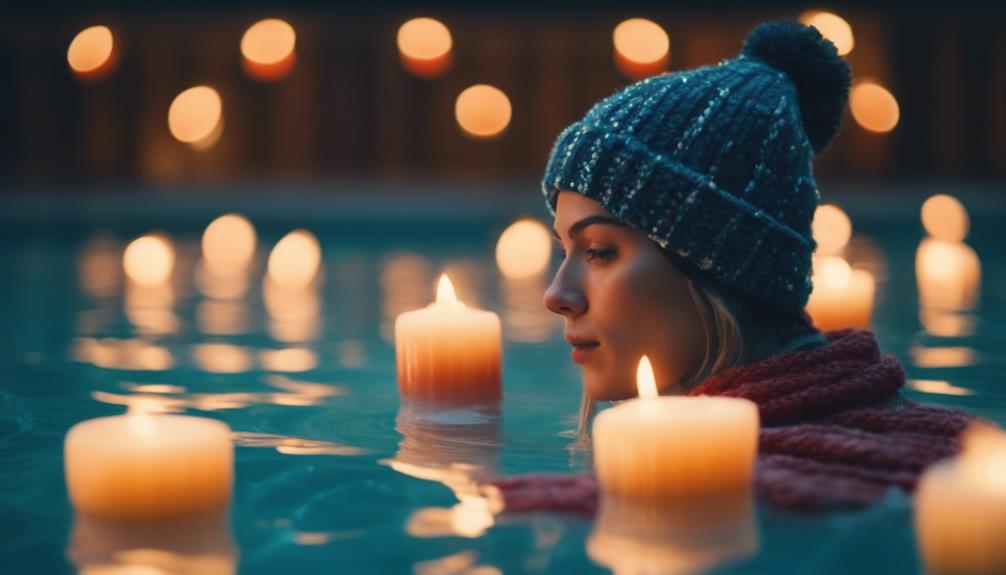The colors you choose for your pool interiors and lighting can greatly influence your mood and how you feel in the space. Cool tones like blues and teals promote calmness and serenity, while warm reds and oranges boost energy and excitement. Lighter shades create an airy, open vibe, whereas darker hues add intimacy and sophistication. By understanding how different colors affect emotions, you can craft a relaxing or energizing environment tailored to your preferences—there’s more to discover about creating the perfect ambiance.
Key Takeaways
- Cool blue or teal lighting promotes calmness and serenity, enhancing relaxation in pool environments.
- Warm tones like reds and oranges evoke excitement, energy, and a welcoming atmosphere.
- Light interior colors such as pastels or neutrals create an open, cheerful, and inviting space.
- Darker shades combined with cool lighting convey sophistication and intimacy.
- Dynamic lighting allows customization to influence mood, making the pool area adaptable for relaxation or celebration.
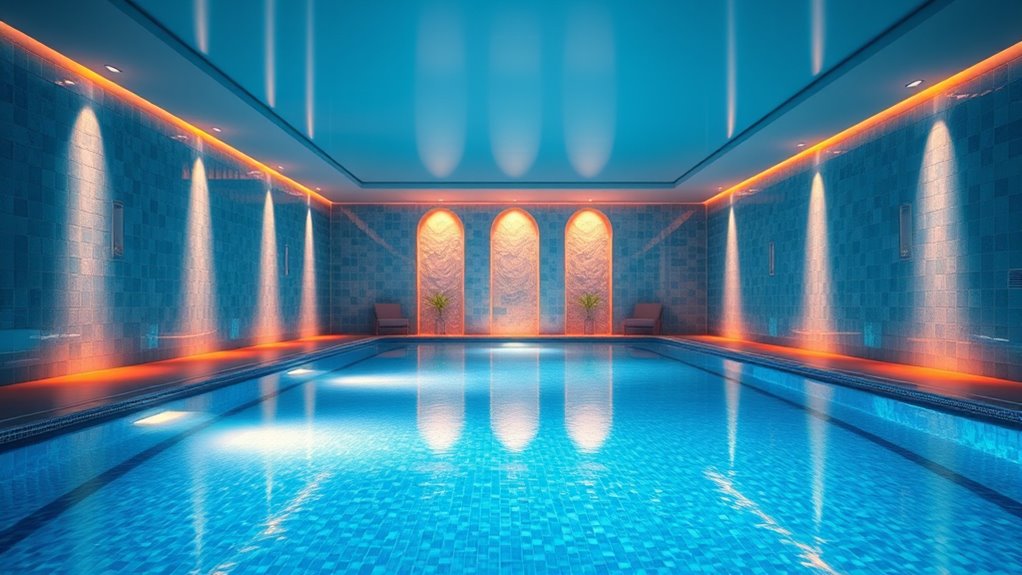
Have you ever wondered how the colors surrounding your pool influence your mood and experience? The way you choose lighting color effects and interior color schemes can dramatically shape your perception of the space. When you step into your pool area, the colors you see don’t just serve an aesthetic purpose—they impact how relaxed, energized, or tranquil you feel. The interplay of lighting and interior colors creates an atmosphere that can elevate your swimming experience or even alter your emotional state.
Lighting color effects are powerful tools in setting the tone of your pool environment. For example, cool blue or teal lights evoke calmness and serenity, making your pool feel like a peaceful oasis. If you want a more energetic vibe, vibrant reds or oranges can stimulate excitement and warmth. Soft, warm lighting tends to promote relaxation, while bright, bold hues energize the space. You can even switch colors throughout the day or evening to match your mood or the occasion. Dynamic lighting setups allow you to customize your experience, whether you’re hosting a party or seeking a quiet retreat.
Lighting colors set the mood—calm, energetic, or relaxing—by transforming your pool environment day or night.
Your interior color schemes play an essential role in reinforcing the mood created by lighting. Light-colored interiors, such as whites, creams, or pastels, reflect more light and make your pool area feel open, airy, and cheerful. Conversely, darker shades like charcoal or navy add a touch of sophistication and create a cozy, intimate atmosphere. When selecting interior colors, think about how they complement your lighting choices. For instance, pairing warm-colored lighting with neutral or earthy tones can generate a welcoming vibe, while cool-toned lights with darker interiors enhance a sleek, modern look. The combination of interior color schemes and lighting effects ensures your pool environment aligns with your desired mood.
You should also consider how these elements influence the perception of space. Light and color can make a small pool area seem larger and more inviting or create an intimate feeling in a more confined space. By carefully choosing lighting color effects and interior color schemes, you’re actively shaping how you and your guests experience the pool. It’s about creating a cohesive atmosphere that resonates with your personal style and emotional needs. When you understand the psychological impact of colors, you empower yourself to craft a pool environment that not only looks stunning but also deeply enhances your overall well-being. Additionally, understanding color psychology can help you select hues that boost relaxation or energy, depending on your preferences.
Frequently Asked Questions
How Do Different Lighting Colors Affect Pool Safety and Visibility?
Different LED color options directly impact your pool’s safety and visibility. Cool colors like blue and white enhance water clarity, making it easier to see beneath the surface. Warmer tones, such as red or amber, may reduce visibility and create shadows, increasing potential hazards. Make sure you select LED colors that improve water clarity and contrast, helping you spot swimmers and obstacles quickly for safer, more enjoyable pool experiences.
Can Color Choices Influence the Perceived Temperature of Pool Water?
You might think color choices don’t influence water temperature perception, but they do. Bright, warm colors like reds and oranges can make the water seem warmer, thanks to color perception cues, even if the actual temperature stays the same. Cooler shades like blues or greens tend to make the water appear more invigorating and cooler. So, your color selections can subtly impact how warm or inviting your pool feels.
What Color Schemes Promote Relaxation Versus Energetic Moods?
You can create a relaxing mood with soft blues, greens, and neutral tones that promote calmness through color harmony, enhancing the pool’s aesthetic appeal. For a more energetic vibe, opt for vibrant colors like bold reds, oranges, or bright yellows that stimulate activity. By carefully selecting your color schemes, you influence the atmosphere you want, making your pool area more inviting and aligned with your desired mood.
How Do Seasonal Changes Impact the Effectiveness of Pool Lighting Colors?
Ever wonder how seasonal color shifts affect your pool’s ambiance? You’ll find that changing seasons influence the effectiveness of your pool lighting colors, requiring you to make ambient light adjustments. During winter, cooler hues may feel more soothing, while in summer, vibrant tones energize your space. By adapting your lighting to seasonal shifts, you guarantee your pool remains inviting and visually appealing year-round. Isn’t it worth tailoring your ambiance to each season?
Are There Cultural Differences in Color Psychology for Pool Interiors?
Yes, cultural differences influence how you perceive pool interior colors. Cultural symbolism and regional preferences shape your reactions to specific hues, making certain colors feel calming or energizing based on your background. For example, you might find blue soothing, while red symbolizes luck in some cultures. Understanding these differences helps you choose pool colors that resonate positively with your cultural context, creating a more personalized and inviting swimming experience.
Conclusion
Understanding the color psychology of pool interiors and lighting can transform your space into a calming oasis or energetic retreat. Did you know that blue hues are proven to reduce stress and promote relaxation? By choosing the right colors and lighting, you create an environment that matches your mood and enhances your experience. So, next time you design or update your pool area, remember—colors aren’t just aesthetic, they influence how you feel every time you plunge in.

